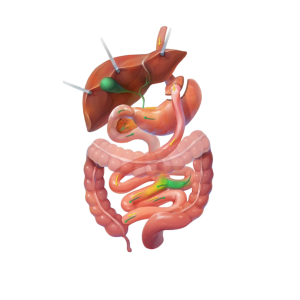Gastric Bypass
Gastric bypass, also known as Roux-en-Y gastric bypass surgery, is one of the most effective weight loss surgery procedures available today. It offers exceptional excess weight loss and provides the average patient with effective obesity-related disease improvement and resolution.1 Owing to these results, many weight-loss surgeons consider the gastric bypass procedure to be the gold standard in bariatric surgery.
Gastric bypass is one of the most commonly performed bariatric procedures in the United States. 2
How it Works:
In the past, gastric bypass surgery was performed as an open procedure, requiring a long single incision in the abdomen. Improvements in surgical techniques now allow the procedure to be performed laparoscopically and robotically, or minimally invasively. Essentially, the surgeon creates 5 tiny incisions in the abdomen through which surgical instruments called trocars are inserted. These trocars act as passageways for the medical devices (scalpel, video camera, etc.) that the surgeons will use to perform surgery. Most gastric bypass procedures will be performed laparoscopically, with or without robotic assistance, unless something about the patient’s surgical profile eliminates that option. Occasionally, the procedure will begin as laparoscopic and be converted to open during surgery.
The procedure works in two ways: restriction and malabsorption. In the first part of the procedure, the surgeon creates a very small stomach pouch, usually about the size of a golf ball, by stapling along the upper portion of the stomach. The new stomach pouch holds about 15 to 30 mL or just a few ounces of food. This means the patient will feel fuller sooner. As a result of the smaller gastric receptacle, the patient will eat less and lose weight.

The second part of the procedure involves the rerouting of the small intestine, essentially shortening it. In doing so, the intestine that remains offers less surface area for calories to be absorbed through the intestinal walls. This portion of the surgical process allows the patient to lose even more weight as calories are restricted, forcing the body to burn existing calories rather than new ones. It is the combination of the restriction of quantity and the malabsorption of calories that create such exceptional weight loss results. The lower portion of the stomach below the new stomach pouch remains functional, continuing to have a blood supply. The remnant stomach remains in the abdomen; however, it will no longer accept any food.
The gastric bypass procedure often lasts approximately 1 hour. Patients are typically released from the hospital within two days, assuming no complications. Patients should be able to resume normal activity between 2 and 4 weeks after surgery. Individual results may vary.
Results:
The results of the Gastric Bypass procedure are excellent and include:
- Excess Weight Loss: Over 60%1
- Resolution of type-2 diabetes: Over 80%1
- Improvement of High Cholesterol: Over 94%1
Learn more about this Procedure:
Advantages of Gastric Bypass
Risks of Gastric Bypass
Gastric Bypass FAQs
References:
- Buchwald H, Estok R, Fahrbach K, et al. Weight and type 2 diabetes after bariatric surgery: systematic review and meta-analysis. Am J Med. 2009;122(3):248-256.
- American Society for Metabolic and Bariatric Surgery. Surgery for morbid obesity: what patients should know. Toronto: FD-Communications, Inc., 2007.

